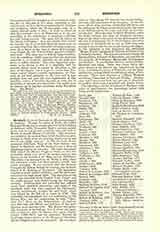

Hereford, Ancient Diocese of (HEREFORDENSIS), in England. Though the name of Putta, the exiled Bishop of Rochester, is usually given as the first Bishop of Hereford (676), Venerable Bede‘s account merely states that he was granted a church and some land in Mercia by Sexulf, Bishop of Lichfield. This, however, was probably the nucleus from which the diocese grew, though its limits were not precisely fixed even by the end of the eighth century. In 793 the body of the martyred Ethelbert, King of the East Saxons, was buried at Hereford, and his shrine became a place of pilgrimage famous for miracles. His name was joined with that of the Blessed Virgin as titular, so that the cathedral, which was served by secular canons, was known as the Church of St. Mary and St. Ethelbert. The shrine was destroyed by the Welsh in 1055, when the cathedral, which had been recently rebuilt, was much damaged. It was restored after the Norman Conquest by Bishop Robert de Losinga, the intimate friend of St. Wulstan of Worcester. His immediate successors made further additions, and the great central tower was built about 1200. The clerestory to the choir, the beautiful Early English Lady Chapel and the north transept were added during the thirteenth century. Unfortunately the cathedral has suffered much from unskillful restoration, and some of the medieval work has been replaced by eighteenth-century architecture, notably the west front, which was ruined by the fall of a tower in 1786. The cathedral was remarkable for not conforming to the Sarum Rite, but for maintaining its own “Hereford Use” down to the Reformation. It had its own Breviary and Missal, and portions of the antiphonary have also survived. The diocese was generally fortunate in its bishops, two of whom are specially prominent: John de Breton, the great English lawyer (1268-1275); and his successor, Thomas de Cantilupe, better known as St. Thomas of Hereford, the last English saint to be canonized. He was chancellor to King Henry III when he was elected bishop, and had wide experience of government. In the disputes which arose between Archbishop Peckham and his suffragans, St. Thomas was chosen to lay the cause of the bishops before the pope, and while on this mission he died. His relics were buried at Hereford, where his shrine became the scene of numerous miracles. Part of the relics were saved at the Reformation and are now at Stonyhurst, but it would appear that some remained at Hereford, for as late as 1610 they were carried in procession by the people during the plague. In the cathedral is still preserved the celebrated “Mappa Mundi”, designed by Richard of Battle in the thirteenth century. The diocese consisted of nearly all Herefordshire, with part of Shropshire, and parishes in the counties of Worcester, Monmouth, Montgomery and Radnor. It was divided into two archdeaconries, Hereford and Salop. There were about thirty religious houses in the diocese, the Augustinians having seven, including the priory of Wigmore, and the Benedictines ten, among which was the great priory of Leominster. There were Cluniacs at Clifford, Wenlock and Preen, Cistercians at Dore and Flaxley. Dominicans and Franciscans both had priories in Hereford; at Ludlow there were Carmelites and Austin Friars.
The following is the list of bishops of Hereford, with dates of appointment, the chronology before 1012 being partly conjectural:
Putta, 676
Thyrtell, 693
Torchtere, 710
Walchstod, 727
Cuthbert, 736
Podda, 746
Acca, c. 758
Aldberht, 777
Esne, 781
Celmundus, 793
Edulf, 796
Utel, c. 798
Wulfhard, 803
Benna, 824
Eadulf, c. 825
Cuthwulf, 838
Mucellus, c. 857
Deorlaf, 866
Ethelbert, 868
Cunemund, 888
Athelstan I, 895
Eadgar, c. 901
Tidhelm, c. 930
Wulfhelm, c. 935
Alfric, 941
Athulf, c. 966
Athelstan II, 1012
Leofgar, 1056
Vacancy, 1056
Walter of Lorraine, 1061
Robert de Losinga, 1079
Gerard, 1096
Vacancy, 1101
Reynelm, 1107
Geoffrey de Clive, 1115
Richard de Capella, 1121
Vacancy, 1127
Robert de Bethune, 1131
Gilbert Foliot, 1148
Robert de Maledon, 1163
Vacancy, 1168
Robert Foliot, 1174
William de Vere, 1186
Giles de Braose, 1200
Hugh de Mapenor, 1216
Hugh Foliot, 1219
Ralph de Maydenstan,1234
Peter of Savoy, 1240
John de Breton, 1268
St. Thomas de Cantilupe,1275
Richard Swinfield, 1283
Adam Orleton, 1316
Thomas Charleton, 1327
John Trilleck, 1344
Lewis Charleton, 1361
William Courtenay, 1370
John Gilbert, 1375
Thomas Trevenant, 1389
Robert Mascall, 1404
Edmund Lacy, 1417
Thomas Polton, 1420
Thomas Spofford, 1421
Richard Beauchamp, 1448
Reginald Buller, 1450
John Stanberry, 1453
Thomas Mylling, 1474
Edmund Audley, 1492
Adrian de Castello, 1503
Richard Mayhew, 1504
Charles Booth, 1516
Schismatical bishops:—
Edward Foxe, 1535
Edmund Bonner, 1538 (translated to London before consecration)
John Skypp, 1539
John Harley, 1553
Canonical bishops:—Robert Parfew, 1554
Thomas Reynolds, 1557 (died a prisoner for the faith before consecration)
The arms of the see were: Gules, three leopard’s heads reversed, jessant as many fleurs-de-lys, or.
EDWIN BURTON

